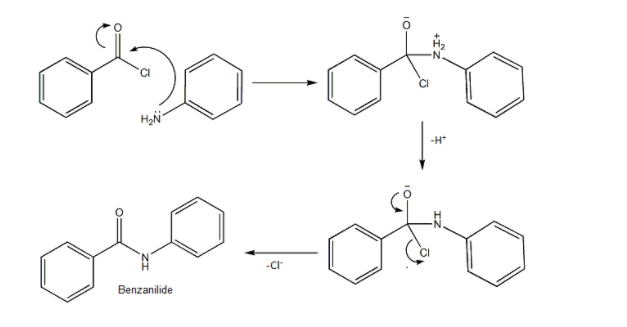
What is obtained when Benzoyl Chloride reacts with Aniline in presence of Sodium Hydroxide?
(A) Benzoic acid
(B) Benzanilide
(C) Acetanilide
(D) Azobenzene
Answer
427.5k+ views
Hint: Nucleophilic N-atoms in Aniline can attack electrophilic atoms of Benzoyl Chloride and give a reaction. The Name of this reaction is Schotten-Baumann reaction.
Complete Step-by-Step Solution:

As shown in the mechanism, the N-atom of aniline is nucleophilic and it attacks the carbonyl carbon of Benzoyl chloride. Carbonyl carbon is often a preferred place for nucleophilic attack.
- Then Proton is lost and consequently, Chlorine anion is removed from the molecule to give neutral product Benzanilide.
- We can see that HCl is also formed during the reaction. So presence of Sodium hydroxide not only catalyses the reaction but also neutralizes the effect of acid formed in the reaction.
- So, option (B) Benzanilide is correct.
Additional Information:
- This reaction involves formation of a C-N bond. We can categorize this reaction to Condensation Reactions.
-A Condensation reaction is a type of a reaction in which two molecules combine to give a product and small neutral molecules like water, Ammonia etc…
- Benzanilide is used as Fungicide and Pesticide as well.
- In this Schotten-Baumann reaction, Pyridine can also be used as a catalyst in place of Sodium hydroxide.
Note:
- Do not get confused between Benzoyl chloride, Benzyl Chloride, Benzal Chloride and Benzo Chloride whose structures are as shown below.

Here no suitable conditions or reagents are present for electrophilic aromatic substitution, So, do not consider it.
Complete Step-by-Step Solution:

As shown in the mechanism, the N-atom of aniline is nucleophilic and it attacks the carbonyl carbon of Benzoyl chloride. Carbonyl carbon is often a preferred place for nucleophilic attack.
- Then Proton is lost and consequently, Chlorine anion is removed from the molecule to give neutral product Benzanilide.
- We can see that HCl is also formed during the reaction. So presence of Sodium hydroxide not only catalyses the reaction but also neutralizes the effect of acid formed in the reaction.
- So, option (B) Benzanilide is correct.
Additional Information:
- This reaction involves formation of a C-N bond. We can categorize this reaction to Condensation Reactions.
-A Condensation reaction is a type of a reaction in which two molecules combine to give a product and small neutral molecules like water, Ammonia etc…
- Benzanilide is used as Fungicide and Pesticide as well.
- In this Schotten-Baumann reaction, Pyridine can also be used as a catalyst in place of Sodium hydroxide.
Note:
- Do not get confused between Benzoyl chloride, Benzyl Chloride, Benzal Chloride and Benzo Chloride whose structures are as shown below.

Here no suitable conditions or reagents are present for electrophilic aromatic substitution, So, do not consider it.
Recently Updated Pages
Difference Between Rows and Columns: JEE Main 2024

Difference Between Length and Height: JEE Main 2024

Difference Between Natural and Whole Numbers: JEE Main 2024

Average fee range for JEE coaching in India- Complete Details

Algebraic Formula

Difference Between Constants and Variables: JEE Main 2024

Trending doubts
JEE Main 2025 Session 2: Application Form (Out), Exam Dates (Released), Eligibility, & More

JEE Main Syllabus 2025 (Updated)

JEE Main Question Papers 2025

JEE Main Marks Vs Percentile Vs Rank 2025: Calculate Percentile Using Marks

JEE Mains 2025 Cutoff: Expected and Category-Wise Qualifying Marks for NITs, IIITs, and GFTIs

Raoult's Law with Examples

Other Pages
Types of Solutions

CBSE Class 12 English Core Syllabus 2024-25: Updated Curriculum

CBSE Date Sheet 2025 Released for Class 12 Board Exams, Download PDF

CBSE Board Exam Date Sheet Class 10 2025 (Released): Download Class 10th Exam Dates PDF

CBSE Class 10 Hindi Sample Papers 2024-25

CBSE Class 10 Hindi B Syllabus 2024-25: Updated Curriculum




